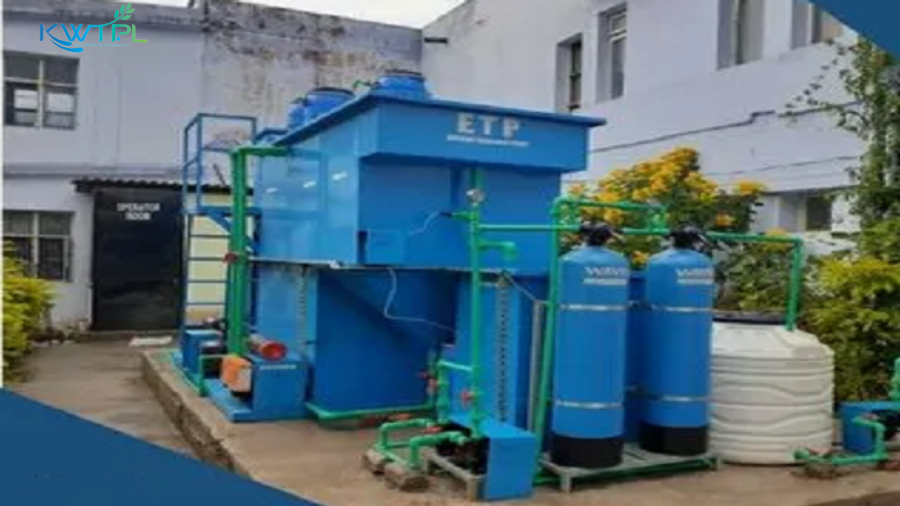ETP Plant For Hospitals

An ETP Plant for hospitals is a crucial facility designed to treat and manage the wastewater generated by various hospital activities. Hospital wastewater, also known as hospital effluent, can contain many contaminants, including chemicals, pathogens, pharmaceuticals, and other hazardous substances that require specialized treatment before being discharged into the environment or municipal sewage systems.
How does an ETP Plant for Hospitals typically work?
Collection and Segregation
Hospital wastewater is collecting from various sources within the facility, such as sinks, toilets, laboratories, operation theatres, and other areas. It’s important to segregate different types of wastewater to ensure proper treatment.
Preliminary Treatment
The wastewater undergoes preliminary treatment where large solids, debris, and other visible contaminants are removing using processes like screening and grit removal.
Primary Treatment
In this step, the wastewater is subjecting to physical or chemical processes to separate suspended solids and organic matter further. Primary treatment can involve processes like sedimentation, coagulation, and flocculation.
Secondary Treatment
Hospital wastewater often contains a high load of organic compounds, pathogens, and dissolved substances. Secondary treatment involves biological processes such as activated sludge, extended aeration, or trickling filters. Microorganisms break down organic matter and pathogens in the wastewater, resulting in cleaner effluent.
Tertiary Treatment
Depending on local regulations and the quality of treated effluent required, tertiary treatment may be employed. This stage focuses on further removing residual contaminants through advanced processes like filtration, chemical precipitation, and disinfection.
Disinfection
Disinfection is a critical step to eliminate harmful pathogens and microorganisms from the treated wastewater. Common disinfection methods include chlorination, ultraviolet (UV) irradiation, and zonation.
Sludge Management
Throughout the treatment process, sludge (semi-solid waste) is generating. This sludge may contain both organic and inorganic materials and requires proper management. It can be further treated through processes like anaerobic digestion, dewatering, and possibly incineration.
Effluent Monitoring
Regular monitoring of the treated effluent’s quality is essential to ensure that it meets the required standards set by local environmental regulations before discharge.
Reuse
In some cases, treated effluent can be using for non-potable purposes within the hospital, such as flushing toilets or irrigation, after appropriate disinfection and filtration.
Benefits of effluent treatment plant for hospitals
Environmental Protection:.
- Reduced Pollution: An ETP ensures that the wastewater generated by hospitals is treated and its contaminants are removing before being discharging into the environment. This prevents the pollution of local water bodies and soil.
- Pathogen Removal: Hospitals produce wastewater that may contain harmful pathogens and disease-causing microorganisms. Proper treatment in an ETP significantly reduces the risk of spreading infections through wastewater discharge.
- Chemical and Pharmaceutical Removal: Hospitals often use a variety of chemicals, medications, and pharmaceuticals. ETPs can help remove or break down these substances, preventing their entry into natural water sources.
Compliance with Regulations:
Legal Requirements: Many regions have strict regulations governing the discharge of wastewater into the environment. Having an ETP ensures that hospitals meet these regulatory standards and avoid potential fines or legal issues.
Resource Conservation:
- Water Reuse: Depending on the quality of treated effluent, hospitals may be able to reuse the water for non-potable purposes such as irrigation, cooling systems, or even toilet flushing. This reduces the demand for fresh water and conserves this valuable resource.
- Energy Recovery: Some ETPs incorporate technologies that allow for the recovery of energy from the treatment process, such as anaerobic digestion of sludge to produce biogas.
Positive Public Perception:
Corporate Social Responsibility: Hospitals that demonstrate their commitment to environmental protection and responsible waste management through ETPs can enhance their reputation and community standing.
Improved Operational Efficiency:
- Lower Operating Costs: Treating wastewater on-site reduces the hospital’s reliance on external wastewater treatment services, potentially leading to cost savings over the long term.
- Avoiding Clogs and Blockages: Proper treatment reduces the risk of clogs and blockages in the hospital’s internal plumbing and municipal sewage system, leading to reduced maintenance and repair costs.
Long-Term Sustainability:
- Futureproofing: As environmental regulations continue to evolve and become more stringent, having an ETP in place ensures that the hospital is preparing to meet future requirements.
- Sustainable Growth: Hospitals planning to expand can incorporate ETPs into their design, ensuring that their growth is environmentally sustainable from the outset.
Health and Safety:
- Worker Safety: Proper wastewater treatment minimizes the exposure of hospital staff to potentially hazardous materials present in wastewater.
- Preventing Disease Spread: Effective wastewater treatment prevents the spread of waterborne diseases, safeguarding the health of patients, staff, and the community.
How to choose the right effluent treatment plant for your hospitals
When it comes to choosing the right effluent treatment plant for your hospital, there are several factors that you need to consider. First and foremost, you must assess the specific needs of your facility. This includes determining the volume and composition of wastewater generated by your hospital daily.
Next, you should look for a treatment plant that is designing specifically for hospitals. These plants are equipping with advanced technologies and features that cater to the unique requirements of medical facilities. Look for systems that can efficiently remove contaminants such as pharmaceuticals, pathogens, chemicals, and heavy metals from the wastewater.
Another important aspect to consider is compliance with local regulations and standards. Ensure that the effluent treatment plant meets all necessary legal requirements and guidelines set by regulatory bodies. This will help you avoid any potential fines or penalties in the future.
Additionally, consider factors such as ease of operation and maintenance when selecting an effluent treatment plant. Look for systems that are user-friendly and come with reliable customer support services.